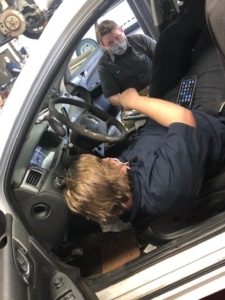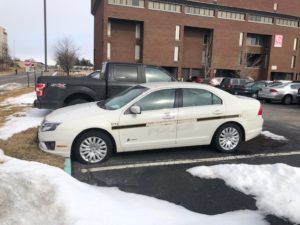By Cristian Romero
The Scene staff
If electric cars and hybrids are the future, then Forest Park automotive technology students need to know how to work on them.

At least that’s the theory behind St. Louis Community College’s recent decision to turn two 2012 Ford Fusion hybrids into practice vehicles after they were “decommissioned” by campus police.
“They’re being used for educational purposes, for students to work on and learn as they go here in the automotive department,” said Joe Jackson, automotive technology program coordinator and associate professor.
Students seem to understand that it’s key for them to develop skills related to the new technology.
“Working on electric and hybrids consists of a lot of electrical wiring and mechanical wiring,” said student Nick Castrino, 24. “But I’m excited to work on them because it’s a pretty common issue, considering where the industry is heading.”
“I enjoy where the automotive program is heading with us, getting the opportunity to get to work on hybrids and electric vehicles on and off,” added student Michael Calberg, 20.
The main difference between traditional and hybrid vehicles is that the former have gasoline-powered engines, and the latter have electric motors powered by battery packs, as well as gasoline-powered engines.
Tesla equipped its electric vehicles with touchscreen interfaces, but early hybrids didn’t have these systems.
“People always assume it’s harder to work on hybrids or electric vehicles, but it’s just more components to work inside the vehicle,” Jackson said.
The automotive technology department has 25 students, including 15 day and 10 night students, in their first year of the two-year program; and 13 day students in their second year.
The department repairs about five vehicles a week or 20 vehicles a month while school is in session. It only accepts jobs from STLCC faculty and staff, charging for parts but not labor.

Occasionally, customers bring in electric or hybrid vehicles. That gets students excited because it’s something different, according to Jackson.
“They aren’t worked on as often as they should be, because the market for hybrids and electric vehicles isn’t in high demand currently,” he said.
“But it’s still great to showcase them so we can prepare our students with the proper knowledge and skills so they can succeed later in their careers.”
A new Ford Fusion would have cost $20,705 to $29,175 in 2012. It came with a 2.5 liter, four-cylinder, 191 horsepower, 6,000 RPM engine and electric motor. It could get 99 to 110 miles per gallon.
The two Ford Fusions adopted by the automotive technology department were formerly used by police on the Meramec campus of STLCC.
“The reason behind decommissioning the vehicles was to make way for brand new and improved patrol vehicles,” said Forest Park officer Charles Kirstea
